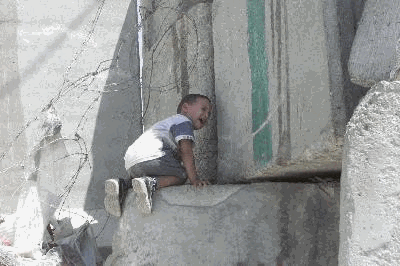
september 2004
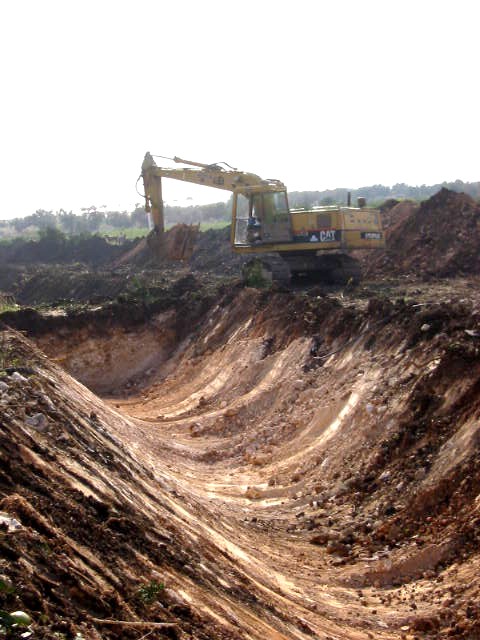

People Behind Walls
"The Wall imposes immense and unnecessary suffering on the Palestinian people" - World Court (ICJ) The Hague.
by Christine Lane* - Jersusalem August 9, 2004 (MMN)
The road carves out its path like a long silver snake, slithering through virgin mountainsides, turning olive groves into concrete slabs It’s guarded by armed border police squatting on rocky outposts, positioned every 25 meters along the route. Bulldozers roar, churning up savage clouds of red dust, while earthmovers delve into volcanic like ditches that herald the beginning of a 25ft high razor fence. A young donkey with a foal in tow hesitates before the ditch unable to proceed further and obviously confused its familiar journey no longer possible. There is no path for man or beast. Large tracts of fertile land stand marooned, and forcibly abandoned, their owners denied access. Patches of old tattered green canvas once a carpet for the olives lie scattered here and there, together with remnants of perhaps what was once the scene of a picnic celebration. Olives trees harvested for centuries, their upturned roots now bared to the sky, plants and herbs long used in traditional Palestinian cuisine wither in the dry grass. Aside from the presence of Israeli police and Palestinian labourers there is not a villager in sight.
This is the scene of the early construction of a small section of Israel’s ‘Separation Wall’ encircling the beautiful old northern Palestinian village of Qafin, near Tulkarem. Like hundreds of other villagers, the residents of Qafin are devastated as they helplessly witness the confiscation of their lands and destruction of the olive groves. But it is a scene now repeated in one form or another throughout Palestinian towns and villages. No area is unaffected and some are more greatly affected than others.
The Separation Wall
When the news broke in 2002 of
Israel’s intention to build a Wall, referred to by
the Israeli government as “a fence”, stretching
the length and breadth of Occupied Palestinian lands, to
separate Palestinians from the West Bank from illegal
Jewish settlers and post 1967 Israel, some thought it a
joke. Memories come to mind, of course the Berlin wall
with its ominous connotations (96 miles long: 155 km, 8ft
high-3.6m; Israeli Wall (403 miles-long-605km, 25ft-high
8m). It’s one fifth the length of the wall of China.
Israel was not joking. The inconceivable has become a
reality. Israel began building the Wall in earnest in
June 2002, and even the term wall is misleading for to be
more precise it is a series of concrete barriers, some 70
meters wide including depth barriers, forming a
no-man’s land, accompanied by electric
‘smart’ fences, razor wire, security patrols
and electronic gates. On the eastern side (Palestinian),
are trenches to act as a obstacles to vehicles, a
two-lane army patrol road, then another fence
The reason given for these massive fortifications, the old adage Israel’s “security”, all else having failed to quench Palestinian resistance to the Occupation. So the Israeli government proceeds with the concept of enforced separation, and with a vengeance.
If the northern section Wall,
itself built at a cost of roughly $2 billion ($1 million
per km) is to set the future permanent boundaries of the
State of Israel it certainly does not follow the
internationally recognised pre-1967, temporary borders,
of the Green Line. The boundary between Israel and
Occupied Palestine is approximately 350km long, so why
one may ask does the route of the proposed Wall stretch
to 1000km? The answer it follows a circular route. It
plunges into existing Palestinian lands, meandering here
and there in pursuit of its victims. It cuts into
existing villages, frequently leaving villagers on the
one side, their lands and water resources on the other
separating them from larger towns and major public
services.
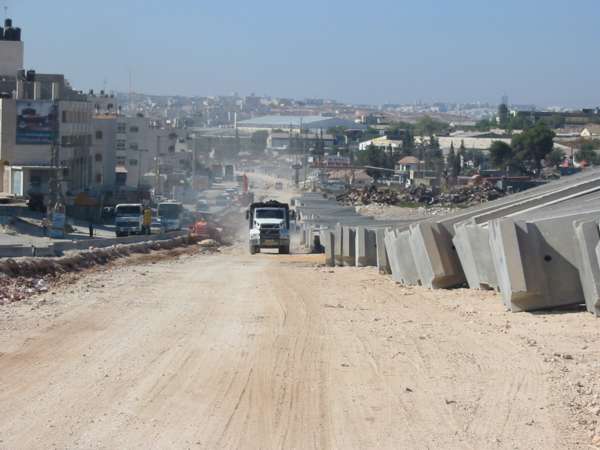
In deference to the illegal Jewish settlers, the Wall is planned to digress some 10 miles deep into the West Bank to encircle and transfer clusters of illegal settlements including Ariel (20,000 settlers) and eventually Kedumin and Immanuel into Israel proper, snatching important Palestinian subterranean water reservoirs in the process. The eventual plan is to join up these walls with the main Wall. The settlers are determined that the Wall absorbs most of them into Israel no matter how far their settlements are from the Green Line. This effectively also places the settlers behind walls and fences. I wonder if there is any historic sense of deja-vu. But for them what was once an open invitation to an exclusive residency has become a dance on burning embers, fired by anger and injustice. President Bush has described the Wall as “a problem” but Israel insists that Washington was not opposed to its construction around Ariel. At the same time PM Sharon has declared that he is working to consolidate Israel’s hold over much larger colonies, where the Jewish population totals some 230,000.
The growing barrier (with a planned length of 600 kilometers at a cost of NIS 8 to 9 billion=$2, billion) will introduce 100 gates to allow access to agricultural land, and 30 checkpoints including several terminals for the movement of goods. In some instances trapping the Palestinians, depriving farmers of their only means of survival is not enough. In the northern village of Zita reports emerge of farmers being beaten as they await the opening of the electronic gate No 542 by border police. If anyone dares touch the fence the gate will not be opened at all that day, as a punishment. In other areas stretches of sand await the arrival of tell-tale footprints. The city of Tulkarem will be separated from the West Bank, on its western side near the Green Line by fences and walls and on the side of the West Bank by a depth barrier, sealing in the town including Tulkarem refugee camp (15, 6000 registered refugees). More than one-third of Qalqilya’s town land, the most important agricultural basket in the West Bank, has been confiscated. In villages around these two cities 30 artisan wells have been lost, 18% of Palestinians share of the Western Groundwater Basin. This drains the already scarce water supplies as for every 10 litres allocated (by Israel) to the Palestinian, 50 litres are allocated to the illegal Jewish settler. Israeli settlers annually discharge 224,000 tons of waste into Palestine, polluting village streams and farms
The town is completely encircled by the Wall and gates overlooked by a watchtower, control the flow in and out-one person or vehicle at a time. The Wall will meander across the fields of 300 farmers and 1,000 farmers will lose significant portions of land to the western side. According to Israeli Human rights organization, B’Tselem 25% who wish to pass through the electronic gates are defined as “prevented from entering”. And the Wall following its current route will infringe upon the rights of over 800,000 people, including 200,000 Palestinian residents of East-Jerusalem who will be cut off from the West Bank. 210,000 Palestinians will be trapped inside 67 villages inside the Wall’s radius, and any home within a 35 meters distance will be demolished.
The second (southern) section is to stretch from Bethlehem to Hebron, cuts off the Bethlehem triangle with its surrounding villages and the refugee camps (comb pop 170,000) from East Jerusalem, and the central and northern West Bank. The 15,000 residents of Kalandia and Kufr Aqab, and Al-Ram (pop 60,000) north of the Wall are likely to lose their Jerusalem residency rights all together. A third smaller section will surround Jericho and finally a further section will completely seal off the Jordan valley to the east thus cutting off Palestine from the rest of the Arab world.
Jerusalem
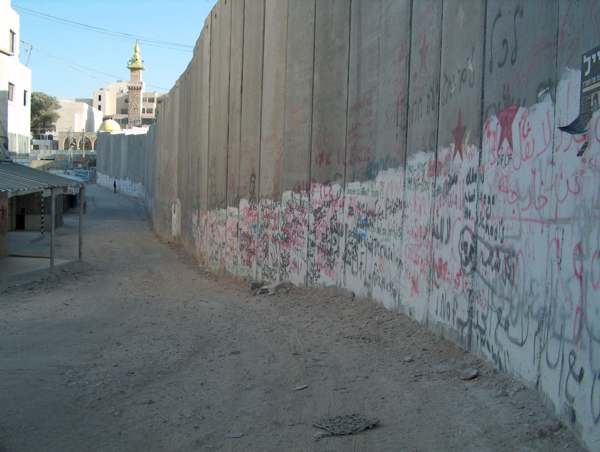
By the time the Jerusalem Wall is completed, 90% of the East- Jerusalem district will be absorbed by Israel. Some 250,000 Palestinians will be stranded in walled enclosures, and will lose access to schools, universities, and medical centres. Plans for this section will carve in concrete Israel’s illegal annexation of the Holy city, and include the annexation of at least 15 settlements including the massive colony of Ma’aleh Adumim, and others. Given that 50% of the settlers live in East Jerusalem much of the land to be confiscated will be to transfer these colonies behind the Wall on the Israeli side, while placing the Palestinian neighbourhoods of the city in limbo. Since 1967 the stated policy of the Jerusalem Municipality has been to create a ratio of 78 Jews for every 28 Palestinians. Land has been confiscated, residency rights revoked, building permits denied, and homes demolished. The Jerusalem Wall ratchets up this policy by carving Palestinian communities out of East Jerusalem and making daily life impossible. This can only be described as a policy of ethnic cleansing. Sharon once described his preference (The Times, 24/8/1988) “You don’t simply bundle people onto trucks and drive them away. I prefer to advocate a positive policy, to create in effect, a condition that in a positive way will induce people to leave.”
An ironic thought. If the Wall is completed as planned, some 16% of the West Bank will be annexed to Israel with its Palestinian residents. Successive Israeli governments have claimed their right to an exclusive Jewish ‘homeland’ yet the logistics of the Wall while leaving Palestinians with only 10% of their historic homeland; will draw in some 400,000 Palestinians stranded on the (wrong side) the Israeli side of the Wall, the buffer zone. They have literally been abducted from the West Bank. They will not be granted Israeli citizenship, or free access into Israel and will need a special permit to visit the West Bank. They may well be shot in the attempt to do so. This will create a new breed of refugees in Israel. One can only speculate as to their future.
The Wall itself is merely an extension of the policies of countless checkpoints and closures imposed by Israel on Palestinian freedom of movement since the mid-1990’s. The separation rhetoric is not a reflection of a real geographic or historical divide between the two peoples, but rather an extension of Israel’s continued Zionist campaign to dominate, to confiscate as much land as is possible in violation of Palestinian human rights, and in complete disregard of the concept of national sovereignty for the Palestinians. The Zionist mind-set is less of a purist ideological movement and more of a collective personality disorder. The construction of the first section of the Wall has proved itself an unmitigated social, economic and environmental disaster. It compounds existing Israel practices of restrictions of movement, bringing even higher unemployment and poverty, high psychological stress and increasing health problems. Life under siege, living behind walls without any degree of personal security, living at the whim of Israel’s boy soldiers, the greatest enthusiasts of ‘shoot to kill’, living in an open air prison and struggling to maintain your family and educate your children. In fact living behind walls.
While only 125 miles of 430-miles
has been constructed, already many thousands of people
are trapped either in enclaves for which they need
permits to leave, or trapped in their homes for which
they need permits to live in, or in a no-man’s land
between the Wall and Israel. Some 20,000 have been
separated from their lands (Palestinian Environmental
NGO’s Network).
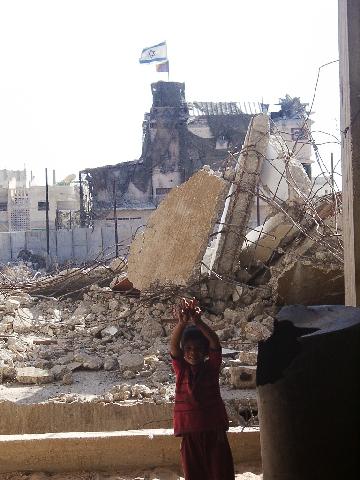
Thirty-seven years of Israel’s brutal Occupation has introduced practices which if implemented in any part of the western world would create a global scandal. The past two years of the has seen an acceleration of horrific policies, the destruction of the Palestinian Authority’s (PNA) headquarters in Ramallah, the physical destruction of the PNA’s police and security services; air raid bombardments of civilian areas most recently Jenin refugee camp in the north and Rafah refugee camps in the Gaza Strip. The use of tank fire, and missiles have left many Palestinian cities as scenes of war-torn areas, now facing further degradation. The construction of the Wall has greatly exacerbated an existing disaster. The natural resources of the West Bank continue to be a major casualty of the Occupation. The most critical impact of the Wall is the loss of yet more agricultural land, greater destruction of the olive trees and orange groves in defence of which many Palestinians have lost their lives. Every aspect of the micro-climate will be displaced. The land is treasured by the Palestinian farmer, and trees play a vital role in preserving the environment and ecological balance of the country. The olive tree is a basic part of the Palestinian landscape, culture and heritage yet 250,000 olive and other fruit trees have been destroyed over the past two years.
The Wall should also be viewed against a background of other concrete necklaces that suffocate Palestine. The Trans-Israeli highway which runs from north to south through a 17% swathe of the West Bank It too has a buffer zone the width of three football pitches on either side. Its creation, as with the Wall, was only made possible through the demolition of Palestinian homes and the virtual desertification of Palestinian land. This Highway compliments the 250 miles of the exclusive settler -only road system, which criss-crosses the West Bank.
As with all of Israel’s policies and actions, the construction of the Wall violates Article 47, 1Vth Geneva Convention which prohibits the annexation of land. Moreover, any destruction of real or personal property by the Occupying power is prohibited except where it is “rendered absolutely necessary for military operations.” Israel argues that the Wall is built for “security purposes”, and not military. Yet it obliterates any temporary borders, greatly increases the geographic map of Israel, and greatly reduces the map of Palestine. When asked by a CNN anchor woman: why not build the Wall on Israeli land current Israeli Finance Minister Netanyahu replied, The West Bank is not Palestinian land, it’s “disputed land”. Really!. This response totally ignores UN Security Council Resolutions. in particular 242 which demands that “Israel withdraw from ‘ occupied Territories’ However Israeli is a master of ignoring international law and the United Nations with impunity, and countless Resolutions concerning Israel, simply gather dust.
It should be irrevocable clear that Israel not only intends to vanquish the Palestinian people, but is intent upon their ‘disappearance’ by one means or another. It is exactly like this for all captive people. Should the Palestinians collaborate with their own extinction? Should they close their eyes believing that they are invisible, and melt into the landscape, that is itself, disappearing? No. Over the past year there have been vigourous protests against the construction of the Wall and Israeli and Palestinian peace groups took the matter to the Israeli Supreme Court; a 3-judge panel gave its ruling on June 31st.
The Court announced that a specific
18 mile segment of the Wall near Jerusalem would separate
35,000 Palestinians from 8,500 acres of cultivated land
and “ the current path would generally burden the
entire way of life in traditional villages.” It
concentrated on the humanitarian aspects stating “it
severely violated freedom of movement and severely
impaired peoples livelihoods. It cancelled land
confiscation orders, and demanded that the government
dismantle the section, return the land and offer
compensation. Sharon in instructing his senior officials
to abide by the Court ruling was so generous in his
response, “I don’t know how many among them
(Palestinians) are farmers, but it is a very hard thing
to take lands from these people, who invested their lives
in these fields”.
| Qurei: Entire
Apartheid Wall Should Be Torn down, Israeli
Ministers Initiate Legislation to Override the
Court Ruling 01/07/2004 Palestine Media Center – PMC Ahead of an advisory ruling by the International Court of Justice (ICJ) in The Hague on July 9, Israel’s Supreme Court on Wednesday ruled to change 30 out of 40 km of the route of the Apartheid Wall the Jewish state is building on occupied Palestinian land north and east of Jerusalem in response to Palestinian petitions. The ruling set precedents for more than 20 other Palestinian petitions. “We have reached the conclusion that the route of the Separation Fence, which separates the villages of Beit Likia and Beit Anan from the lands which provide the villagers with their livelihood, is not proportionate,” the ruling said. “The current balance between security considerations and humanitarian considerations is disproportionate,” the court added. It further ruled that “the IOF Commander should reduce the infringement upon the local inhabitants, even if it cannot be totally avoided, by altering the path of the fence in most areas complained of in the petition.” “The route ... injures the local inhabitants in a severe and acute way while violating their rights under humanitarian and international law,” it decided. Israeli Chief Judge A. Barak wrote the judgment. Vice-President of the court E. Mazza and Judge M. Cheshin concurred. The Court divided its discussion into two parts, each addressing a separate question. The first question concerns the legal authority of the IOF Commander to build a wall in the West Bank. The second question concerns the proportionality of the Wall’s path. The Court accepted the IOF Commander’s position regarding the security aims of the Wall, rejecting the contrary position of the Council for Peace and Security (an Israeli private organization composed of retired military commanders that submitted a brief on the appropriate security aims, and hence the proper path, of the Wall). According to IOF Colonel Danny Tirza, who is in charge of planning the Wall’s route in the Central Command, “Today an Israeli court awarded the Palestinians a decisive victory against the minimal security measure that we have created.” Labor MP Amram Mitzna said. “The court ruled in favor of a fence and security, but not according to the route that was planned by the government,” he added. However, following the High Court’s decision Wednesday morning, three cabinet ministers – Dani Naveh, Natan Sharansky and Zvulun Orlev – initiated legislation that could circumvent the court’s decision, Maariv reported. Israeli Prime Minister Ariel Sharon will meet with legal and military officials Thursday night to discuss the ruling’s ramifications. The “Defense” Ministry also said earlier Wednesday it would reroute part of the Wall in the wake of the High Court order. “The re-planning of these sections will be based on the principles set by the High Court, namely the proper balance between security and humanitarian considerations,” the Israeli Ministry claimed in a statement. Precedent for Hearings on more than 20 Palestinian Petitions : Mohammed Dahleh, the lawyer representing the Palestinian villagers affected by the ruling, hailed the judges’ “important and very courageous” decision, adding it was more important than an upcoming verdict by the ICJ on the barrier’s legality. “This ruling will have a major impact on the judicial fight against the racist wall and will influence the (Israeli occupation) army's planning for its route,” Dahleh told AFP. “It is more important than the world court’s decision because Israel has already made clear that it will not pay any heed to the advice of the ICJ,” he added. The court’s ruling related to a section of the Wall running near Jerusalem’s illegal Jewish settlements of Ramot, Mevasseret Zion, Givat Ze'ev and Har Adar. This section of the Wall in the northeastern Jerusalem area would disrupt the lives of more than 50,000 people living in 10 villages, cutting them off from their farmland, schools, hospitals, jobs and other public services, Dahla said ahead of the ruling. Moreover, about 12,000 acres of Palestinian land would remain on the Israeli side, and another 600 acres will be confiscated for the Wall itself, Dahla added. The Supreme Court focused on the humanitarian aspects of the barrier, saying it “severely violated” the freedom of movement and “severely impaired” people’s livelihoods. “The wall was choking all of our lives. That’s why the decision is important,” said Mohammed Abu Eid, a 54-year old father of 10 whose crops were uprooted to make room for the Wall. The court ordered the government to return land that has been seized and compensate the Palestinians for their financial losses. With Wednesday’s decision, similar lawsuits are likely for other parts of the 425-mile complex of fences, concrete walls, trenches and razor wire. “We won’t stop here,” said Mohammed Dahla. “We will continue our legal struggle against this wall.” The three-judge panel said its unanimous thumbs-down to a planned 30-km (18-mile) segment of the Wall would set guidelines for hearings on more than 20 Palestinian petitions against sections of the network of fences and walls. |
Of much greater significance and in December 2003 the UN General Assembly transferred the matter of the Wall to the International Court of Justice (ICJ) in The Hague, the highest legal body in the UN. Following deliberations in February 2004, it gave its ‘advisory opinion” on July 9th 2004. In an unprecedented ruling the World Court declared by 14-1 (one American judge’s dissent) the Separation Wall built on Palestinian land is contrary to international law and must be dismantled. The Court further demanded that Israel make reparation to all persons whose homes, businesses and farms were destroyed or confiscated for constructing the Wall. Significantly the Court ruled that the Wall violated the Palestinians right to self- determination, which Israel has argued was never explicit in any UN Resolution. Most importantly, the Court asked the UN Security Council “to take action to bring an end to the illegal situation resulting from its construction.” With this it restated the historic and political relevancy of past United Nations Resolutions, particularly 242.
Finally on July 21st, 2004, the UN’s General Assembly voted overwhelmingly a Resolution demanding that Israel comply with the I CJ’s ruling, namely that Israel dismantle the Wall, and pay reparations to the Palestinians directly affected. The vote was carried by 150-6, with ten abstentions; the USA and Israel voted against. As with the ICJ ruling, the Resolution is not legally binding but it carries symbolic significance and reflects the body of world opinion.
However, feverish Israeli political
and diplomatic moves followed in a desperate attempt to
block the ICJ’s ruling from reaching the Security
Council with the collaborative support of the USA and the
European Union who abstained in the Assembly’s
December ruling. 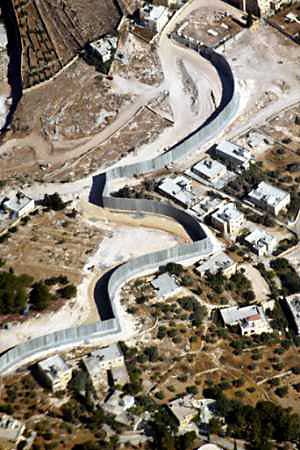
The United States has already promised Israel that it will veto any decision or sanction passed by the Security Council. The Court’s mandate is clear, the Wall must be dismantled and victims compensated, and for the Council to not comply would have grave repercussions for the standing of the ICJ. Prime Minister Sharon the unyielding architect of the Wall remains determined, undeterred by the ruling. Yet fourteen judges from diverse cultures including four veto-holding members favoured the decision. But a US veto would carry grave repercussion, and plunge the Region and the Middle East into even deeper dilemma.
But should Sections of the Wall remain on Palestinian land it will make the establishment of a viable, thriving Palestinian State virtually impossible and it will achieve no security advantage for Israel. It will further impoverish the Palestinian community, and for some provide the ultimate challenge. Its unimpeded construction would reflect the failure of peace process over the past ten years, and the abject failure of American policy, and the failure of the international community to live up to its moral and legal obligations. There is nothing in the mentality of Ariel Sharon and his ilk that cares for a solution based on justice for the Palestinians. Yet George Bush continues to pour billions of dollars into Israel which funds Israel’s military apparatus, its settlements and now the construction of the Wall. Its foundations entirely overshadow the road map to peace. When the Wall is completed Israel would have gorged upon a further 16% of the West Bank; some 500,000 would have lost their homes, land and livelihood and more than 230,000 illegal settlers transferred beyond the pre-1967 borders taking the land with them. Unless urgent action is taken to oblige Israel to remove every trace and fabric of the Wall, and facilitate the rehabilitation of the horrific damage to the Palestinian land and its people, the consequences will bring a human and ecological catastrophe of nightmarish quality. Should this occur we should all pay the price.
This article
was presented at the International Congress of the
Women's International League for Peace & Freedom ( http://www.wilpf.org/ ) by its Palestine Section, in
Sweden, August 2004. Shesent this article to
Montreal Muslims News for publication. Christine Lane can
be reached at :
christinelane2002@yahoo.com
